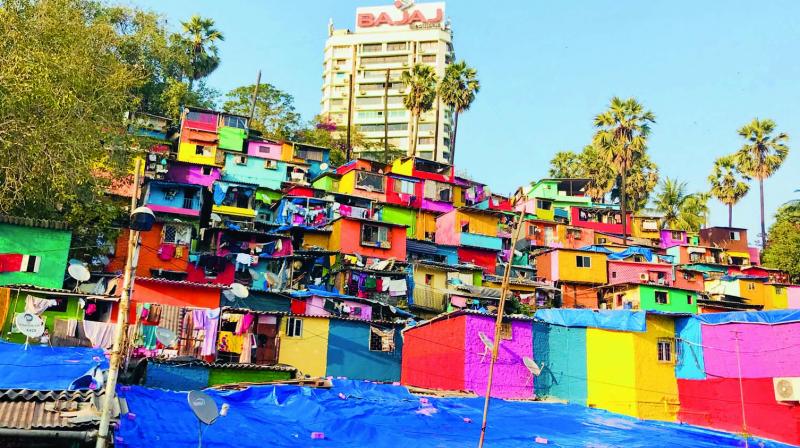Mumbai setting a misaal

Slums in Mumbai, even in and around the more posh localities, bestow upon the city a dilapidated, decrepit look that belies the real spirit of its people. In recent weeks an extremely visually appealing transformation is taking place in some of the slum areas that is changing the visual perception of the city. In the deepest cores of the slums, an eye-catching bunch of homes perched atop a hillock painted in a kaleidoscope of colours visible from afar is attracting attention for all the right reasons.
The project, of creating an aesthetically appealing skyline, is called Misaal Mumbai and is being done almost in mission mode by artist Rouble Nagi under the aegis of the Rouble Nagi Foundation. However, closer examination revealed that it is not just the visual manifestation or beautification. The aim of Misaal Mumbai is to improve the quality of life of people living in slums by providing better and more hygienic living conditions, beautifying the slum homes along with repairs, waterproofing roofs and improving sanitation. Simultaneously sensitisation drives for health, hygiene, sanitation, primary school education enrolments as education is the cornerstone of the foundation are being held.
“As an artist I believe that nature has already given us the best colour palatte. The landscape around our site was blooming with inspirational colour ideas. Trees suggest an earthy palette of greens and browns. A beach setting suggested vivid blues and turquoises or even shades of pink. My philosophy is very simple: Houses in the slums aren’t optimally positioned on the plot, so I simply follow the sun. Colour needs light and goal is always to harmonize, which is what we did,” says Rouble. Extensive and detailed visual maps were made from photographs to choose the colour positioning. Volunteers and painters were given the maps to follow, which they did to amazing impact.
Poonam Mahajan, the MP from Mumbai North Central and president of Bharatiya Janata Party Yuva Morcha and Ashish Shelar MLA Bandra (West) Bhartiya Janata Party and president have extended their whole-hearted support to the project.
The foundation had painted parts of Dharavi over two years ago and intends to take it forward in more parts this year too. Over 285 plus houses in Jaffar Baba Colony will be painted. Plans are afoot to target eight more slums — Dhobi ghat, Colaba, Cuff Parade, Ambedkar Nagar, Machlimar area, Worli Nakka, Kamatipura and Mount Mary.
“What an experience! Unforgettable! So much warmth, love and affection from people, they joined me and my team, worked with us, helped us by identifying better ways to approach specific areas, fed us — or rather over fed us!” says Rouble enthusiastically.
There was a team of 25-30 volunteers, art students, and the foundation team working almost round-the-clock and were joined by the community as well. Some of the younger volunteers from art colleges were trained in painting workshops and ended up employing 25 students to finish the project in less than two months. The result will be “an explosion of rainbow hues that would be visible from far away, stretching from one dwelling to the next in a wave of unexpected energy,” says Rouble Nagi.
While it is a quick way to create visual impact, the projects will also employ people and give them a sense of ownership over the artworks they create in their own community while improving the condition of their houses. A waterproof exterior has been created which should last long. Water will just slide off the walls and the wall will not even get wet. The paint will also stop small cracks from appearing. Mumbai’s Slum Rehabilitation Authority (SRA) has undertaken the rehabilitation in certain parts, but then till that time, people living here don’t need to suffer year after year.
“I have been working in these slum areas with my foundation for the last nine years. Nearly 62 balwadis, paathshallas and such community initiatives across the country have been adopted by my foundation. The intent is to give life to the slum and keep it clean and hygienic. “We merely want to create interventions that hopefully ignite some other change and help others to set up projects of their own, be it Mumbai or anywhere else in India,” says Rouble.
The fact is that street art opens a window for discussion, it also opens doors for some positive ambience in places. Colourful and bright surroundings change the sense of well being of the local community and increasingly the urbanscapes across the country need it to motivate the community, address alienation and improve living conditions and this really is a big step forward for a city that needs it the most — at least in India.
The writer is an art writer, curator and artist and can be contacted at alkaraghuvanshi@yahoo.com


